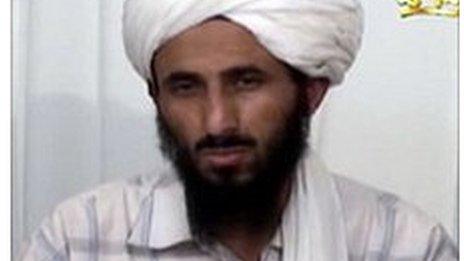Profile: Al-Qaeda 'bomb maker' Ibrahim al-Asiri
- Published
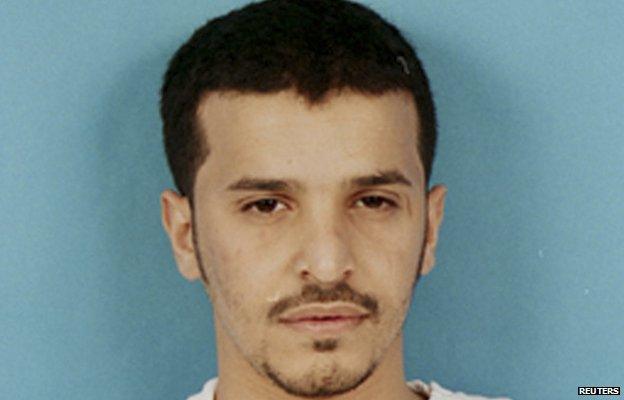
Ibrahim al-Asiri was first named on a Saudi wanted list in February 2009
Ibrahim Hassan Tali al-Asiri is a wanted Saudi militant who US counter-terrorism officials have accused of making the bombs used in a string of high-profile operations by al-Qaeda in the Arabian Peninsula (AQAP) since mid-2009.
The 28-year-old is believed to have built the device his younger brother used in an assassination attempt on Saudi Arabia's deputy interior minister in August 2009, and the underwear bomb a young Nigerian man tried to detonate in an aircraft over the US on Christmas Day.
He is also thought to have made the bombs hidden in two packages which were found on planes in Dubai and the UK in October 2010.
Both were shipped from Yemen, where he is based, and used the powerful explosive pentaerythritol tetranitrate (PETN), which was also used in the two earlier attacks. The packages were addressed to synagogues in the US.
And in May 2012, US officials said they believed Asiri had built an improved version of the underwear bomb, which was reportedly given to a Saudi-recruited double agent to blow up on a US-bound flight.
Wanted list
Known by the alias "Abu Saleh", Mr Asiri was born in April 1982 into a pious military family in the Saudi capital, Riyadh.
Little has been reported about his early life, but he had four brothers and three sisters, and was previously imprisoned in the Gulf kingdom after trying to enter Iraq to join Islamist insurgents there.
"They put me in prison and I began to see the depths of [the Saudi] servitude to the Crusaders and their hatred for the true worshippers of God, from the way they interrogated me," Asiri was quoted as saying by a al-Qaeda-produced magazine in September 2009.
In 2007, the family was living together in the holy city of Mecca when he and his younger brother, Abdullah, went missing.
"We were planning to move back to Riyadh, but Abdullah and Ibrahim said they wanted to go to Medina before returning with us," their father Hassan, a retired soldier, told the Saudi Gazette in 2009, external.
"Abdullah later contacted us to say he was out of the country, but did not say where. From that day on we had no more news of him until we saw his and his brother's pictures... in the media on a list of wanted people."
Ibrahim's was the first name on the list of 83 Saudis and two Yemenis, external who the Saudi authorities said were wanted for "participating in extremist activities abroad" with "deviant groups". Abdullah was number 40.
Officials said the men had entered Yemen illegally and joined al-Qaeda in the Arabian Peninsula, formed in January 2009 by a merger between two regional offshoots of the international Islamist militant network in Yemen and Saudi Arabia.
AQAP established strongholds in central and southern Yemen, where it was protected by tribes who were wary of government interference. It took on new recruits, external and experienced fighters returning from Iraq and Afghanistan, including several former detainees at Guantanamo Bay, external.
'Despicable act'
The group's first operation outside Yemen, external was carried out in Saudi Arabia in August 2009 against the kingdom's security chief, Prince Mohammed Bin Nayef Bin Abdul Aziz Al Saud, though he survived with only minor injuries.
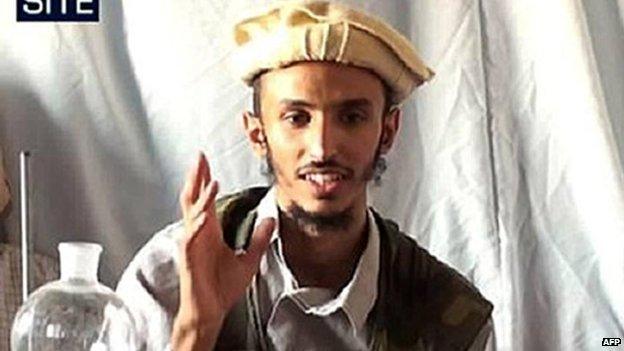
Ibrahim al-Asiri's brother, Abdullah, posed as a militant who wanted to repent
The suicide bomber - who was later named as Ibrahim's 23-year-old brother, Abdullah - concealed a device containing about 100g of PETN inside his body or inside his underwear. It used a detonator with a chemical fuse, which would not be spotted by a metal detector, Saudi officials said.
Posing as a militant who wanted to give himself up in person to the prince,, external Abdullah was flown on his private jet to the city of Jeddah and given a private audience in the interior ministry offices there.
Pictures of the aftermath showed a sizeable crater in the concrete floor, and Abdullah's body blown in half. It is believed the force of the blast went downwards, which is why only the bomber died.
After the assassination attempt, their father said he was shocked that Abdullah could have been involved, and complained that his son had been "snatched from his family" by extremists. Some reports suggested that Ibrahim had recruited his brother.
"We denounce this despicable act, and we stand right beside our guardians in the face of the enemies of the nation and the Ummah [Muslim community]," he said.
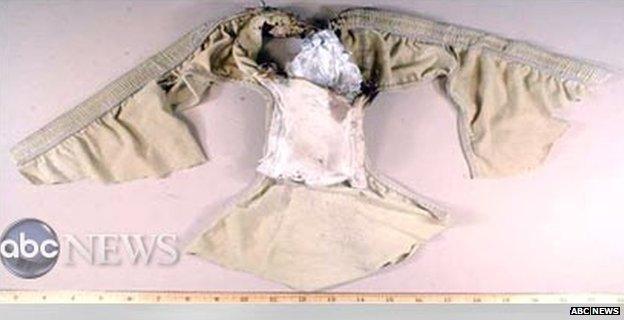
Umar Farouk Abdulmutallab's underpants contained an explosive device
Underpants bomb
After the death of his brother, Ibrahim is thought to have designed the underpants bomb allegedly used by a young Nigerian man, Umar Farouk Abdulmutallab, external, in an attempt to blow up a US passenger jet as it flew into Detroit on 25 December 2009. That device also contained PETN and had a chemical fuse.
AQAP later released a statement saying it had sought to avenge recent raids by Yemeni forces aided by the US military and intelligence services.
Ten months later, in the wake of the alert over the bombs sent from Sanaa to the US through cargo firms UPS and FedEx, Mr Asiri was accused by unnamed US officials of making the devices.
The devices both contained PETN, and one of the detonators was almost exactly the same as the one made for Mr Abdulmutallab, they added. Pictures released by Dubai police showed one bomb was hidden inside a printer.
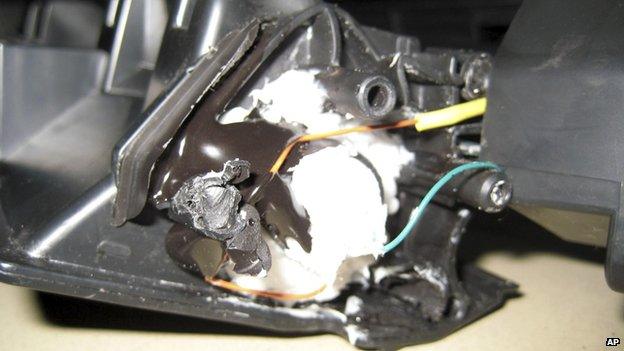
Another bomb was hidden in a printer and posted from Yemen to the United States
The US Deputy National Security Advisor for Homeland Security and Counterterrorism, John Brennan, did not name Mr Asiri but confirmed that the same person was believed to have made the underpants bomb, external.
"I think the indications are right now based on the forensics analysis that it's an individual who has been responsible for putting these devices together, the same," he told ABC News.
"He's a very dangerous individual - clearly somebody who has a fair amount of training and experience. We need to find him and bring him to justice as soon as we can," Mr Brennan added.
Mr Asiri subsequently became a major focus of US intelligence efforts and in March 2011 he was officially designated a wanted terrorist.
In September, US officials believed he had died in a missile strike that killed the US-born radical Islamist cleric, Anwar al-Awlaki. However, it soon became apparent that Mr Asiri was still alive.
As the first anniversary of Osama Bin Laden's death on 1 May 2011 approached, a joint intelligence bulletin issued by the US Northern Command, the FBI and Homeland Security Department, external expressed concern that al-Qaeda intended to "advance plots along multiple fronts, including renewed efforts to target Western aviation".
Then on 6 May, US officials said they had and their allies had foiled a plot to bomb a US plane, involving a device that bore the "hallmarks" of the underwear bomb carried by Umar Farouk Abdulmutallab in 2009.

Since the threats emerged, security has been stepped up at many of the world's major airports
The planned suicide attack was conceived in Yemen by AQAP, but was thwarted before a target had been selected, they added. It later emerged that the would-be bomber was a Saudi intelligence agent.
The device was reported to be a sophisticated construction. Officials said the main charge was a high-grade military explosive which would have been able to bring down an aircraft, and that it could have been detonated in two ways, in case one failed.
The bomb also had no metal parts and probably would not have been detected by most airport security magnetometers. Sewn into custom-made underwear, it would have been hard to detect during a pat-down.
Officials said the latest device bore the "hallmarks" of Ibrahim al-Asiri.
'Proliferation'
Advanced bomb-making techniques, such as those taught by Mr Asiri, have continued to alarm security services.
In July 2014, the US requested enhanced security checks on all direct flights to the US, in response to a "credible threat".
Security experts say that the warning was triggered by a fear that some of al-Qaeda's sophisticated bomb-making expertise, such as that pioneered by Mr Asiri, had proliferated out of Yemen to Syria.
In addition to his expertise in bomb-making, Mr Asiri is also said to be an expert in preparing poisons and well-versed in martial arts.
He is thought to be hiding under the protection of local tribes in the mountainous governorates of Shabwa and Marib with AQAP's leader, Nasser al-Wuhayshi, a Yemeni former aide to Osama Bin Laden.
- Published2 November 2010

- Published31 October 2010
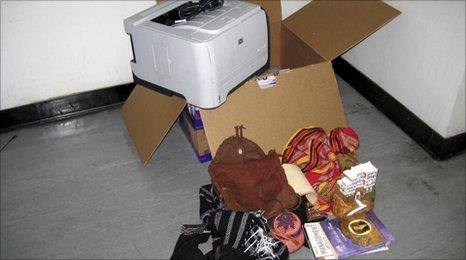
- Published2 November 2010
- Published16 June 2015
